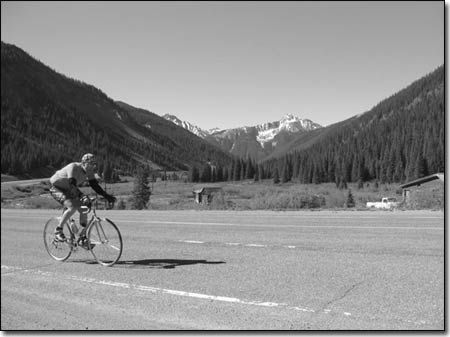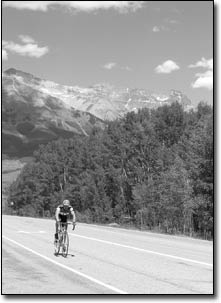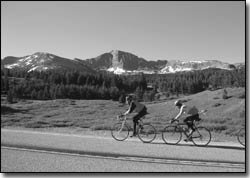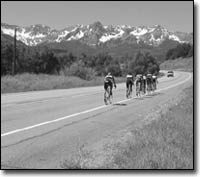|
Death Ride puts cyclists through 228
miles in a day
by Amy Maestas
 |
| Early in the day, Fred Hutt grunts
up the highway from Silverton toward Red Mountain
Pass./Photo by Jenna Hutt |
Last week, long before the sun had even stirred, a
group of six locals - dubbed crazy by others and even
themselves - set off to travel the famed San Juan Skyway.
Not impressive? Perhaps it isn't - if you're driving
a car. But these "crazies" were on nothing but two wheels.
The cycling enthusiasts set off to do the 228-mile loop,
starting and ending in Durango. And they took only the
day to do it. It is aptly named the "Death Ride," for
which no explanation seems necessary. In fact, there
aren't many explanations for the Death Ride, other than
it is, as originator Bob Gregorio puts it, "a group ride
amongst friends."
But it is also known in the cycling community as a sort
of "underground event." Cyclists abound in this part
of the state, especially since the terrain provides a
range of riding for a range of cycling levels. There
are also legions of organized races and events that demand
skill and fitness. These are on the surface for cyclists.
The Death Ride, in contrast, is equally, if not more,
demanding, and is talked about with regard not used for
other rides.
"It's like riding a world-class course in one day," says
rider Fred Hutt.
 |
| Mike
Docherty puts one pedal in front of the next above
Telluride and en route to Lizard
Head Pass./Photo by Jenna Hutt |
This year was the 25th anniversary of the Death Ride - though
no one thought about that until the day after it was
over. You see, the ride is unofficial and so informal
that these kinds of trivial things slip by unnoticed.
The ride's casual history begins with Gregorio. In 1979,
working with the Outdoor Pursuits programs at Fort Lewis
College, Gregorio organized the 228-mile ride just for
fun. He billed it as a two-day ride, with an overnight
stop in Ouray. The cyclists pulled it off. But by the
following year, when Gregorio decided to organize the
Death Ride again, he and others significantly upped the
challenge by making it a one-day ride instead.
Why?
"Well, we were athletes looking for a greater challenge," says
Gregorio.
Over the years, the course has stayed the same, but
the dynamics have changed and new challenges have come
along. This includes everything from participants to
weather. Yet, in spite of these things, the informal
gathering of cyclists takes place each year. Because
the riders do it in one day, Gregorio says they try to
do the ride during the full moon and near the longest
day of the year. This provides longer daylight hours.
Still, there is plenty of darkness on the ride - riders
leave in the wee morning hours and return as the sun
is setting.
"This year we did it in 17 hours, but I'd say the average
is about 16 hours," Gregorio explains the day after the
infamous ride. "I'm pretty worked today. I think I lost
five pounds yesterday. No, I really did."
Although Gregorio is regarded as the founding father
of the ride, he stopped doing the rides for about 12
years during the 1990s.
"I took those years off to 'get a life,'" he says. By
this, he means he married and had children. Those priorities
took precedence over the annual Death Ride. Still, the
Death Ride went on without him. Then, last year, Gregorio
rejoined the ride he christened.
"I got a life but I still pursue my various endeavors," he
explains.
 |
| On
only the second of many major passes, Fred Hutt and
Bob Gregorio work their way to the top of Molas./Photo
by Jenna Hutt |
Gregorio was back at work as a bike mechanic the day
after the Death Ride. He didn't have time to spare, but
he wasn't gloating.
During his absence, Gregorio says, more and different
people experienced the Death Ride. It scared some away,
while hooking others. Some years, the group grew to include
as many as 12 riders. But usually the number of riders
is only a handful.
"It is so classically difficult that I always knew it
would weed out a lot of people," he adds.
This year, six men and two women ventured over several
of the most difficult mountain passes in the Continental
West. Riders included Gregorio, Hutt, Rick Callies, Linda
Paris, Emily Loman and Mike Docherty.
All of them gathered for what Gregorio calls the ultimate
and only prize: common fatigue and pain. Fortunately,
they all thrive on a test of physical endurance and mental
moxie.
"The first time I did it, I wanted to see if I could
do it. The second time I did it to see if I could do
it and enjoy it," says Callies, whose second ride was
this year.
The official word from Callies is that he did, indeed,
enjoy it this year. He is also officially part of a crazy
group.
"Every time I heard people talk about doing this ride,
I thought they were crazy," he says.
This year Callies decided to do the Death Ride only
a few days before it was scheduled. The last-minute decision
paid off, mostly because this year's riders didn't engage
in a pseudo-race, he explains.
In the past, some people turned the Death Ride into
a race, where it was a daylong game of attack-and-chase.
Ultimately, this burned out everyone too quickly and
even tainted the spirit of the decades-long ride.
"This is not something that's enjoyable to be ridden
as a race," says Hutt, who has finished the ride three
out of the four times he's attempted it.
 |
| Riders take advantage of
the group as they
draft their way up Dallas Divide. The six
were well into the ride but still more than
100 miles from home./Photo by Jenna Hutt |
With Gregorio back, Callies says, he thinks the Death
Ride will continue in the spirit it was born with - a
ride without pressure and pretense. Hutt agrees. In fact,
he says he rode this year because Gregorio was on board.
"Since he's the founding father, I wanted to do it with
him and do it in the fashion of a team ride," says Hutt.
All three of these riders attribute the longevity of
the ride to this prevailing approach. "Nothing is official
about this ride, which, for me, is part of the appeal," Gregorio
says, always emphasizing that it is not a race.
As the originator, he isn't interested in turning the
Death Ride into an organized event either. Neither are
its other participants. They like the anti-establishment
nature of a ride with a good reputation. Which, by the
way, is enhanced because there have never been any serious
injuries or "death."
"It just shows us that there is a crazy person born
every minute," says Callies.
|